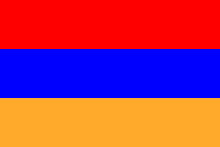Piedmontese Republic
The Piedmontese Republic (Italian Repubblica Piemontese ) was an Italian subsidiary republic founded by French revolutionary exports , formed from the former Principality of Piedmont (part of the Kingdom of Sardinia ), proclaimed on December 10, 1798, dissolved during the Second Coalition War in September 1799, reconstituted in June 1800 under the name Subalpine Republic (Italian Repubblica Subalpina ), dissolved by French annexation on September 11, 1802. For the region under French rule, the name Subalpines Gaul ( Gaule Subalpine ) was also used at the time .
Piedmontese Republic (1798–1799)
The successful cannonade of Valmy allowed France an offensive advance of its armies in the First Coalition War from autumn 1792 . French troops marched into the Savoy region of the Kingdom of Sardinia to liberate and annex it after a national convention had declared the people of Savoy to be sovereign. From 1794 France also advanced into Piedmont, but was initially repulsed by Austria. The victorious Northern Italian campaign of General Napoléon Bonaparte from 1796 forced the King of Sardinia to cede Savoy and the county of Nice to France. Although the two states still concluded an alliance in 1797, the continuing danger of war in Italy and the uncertain situation of the Cisalpine and Roman subsidiary republic of France prompted an expansion of its power; it forced Sardinia in the Treaty of Cherasco to give up Piedmont, which came under French military administration. On December 10, 1798, the Piedmontese Republic was proclaimed in the capital Turin , which was given a constitution based on the French model. After the beginning of the Second Coalition War in the spring of 1799, the French collapse in Italy led to a rapid advance of Austro-Russian troops, which occupied Turin on June 20, 1799 and dissolved the Piedmontese Republic. The King of Sardinia returned.
Subalpine Republic (1800–1802)
In 1800 the French army managed to recapture Italy under the command of Napoléon (Alpine crossing at the Great St. Bernhard Pass and victory at Marengo ). Turin fell on June 20, 1800, the king of Sardinia was declared deposed a second time and the republic was again proclaimed; this time under the name of the Subalpine Republic, which was under French military administration and whose army was incorporated into that of France. From April 1801 to September 1802 only a provisional government ruled the state, and on September 11, 1802 France annexed its daughter republic as part of the reorganization of Italy (restoration of the Kingdom of Naples and the Papal States , transformation of the Duchy of Tuscany into the Kingdom of Etruria and the Cisalpine into the Italian Republic ). Piedmont, Savoy and Nice were only detached from France in 1814/1815 during the Congress of Vienna after the end of Napoleonic rule and reunited with the restored Kingdom of Sardinia .
Remarks

- The names Piedmontese Republic and Subalpine Republic basically mean the same thing. Piedmont literally means at the foot of the mountain , the term subalpine literally below (analogously also at the foot ) of the Alps . The Subalpine Republic moved linguistically closer to the neighboring Cisalpine Republic, which made clear the status of both as French subsidiary republics and Northern Italian sister republics.
- The Subalpine Republic had coins minted on the model of the French franc , on which their coming annexation was announced in language. Coins from 1800/1801 are already inscribed in French and have the formula “Liberté - Egalité” (freedom - equality) on one side with the annual reference “L'an 9” (year 9, according to the French revolutionary calendar ); on the other side appear the allegories of Francia and the Subalpina, framed by the inscription "Gaule Subalpine" - Gaule means Gaul, the ancient name of France. Although the Romans also referred to Northern Italy as "Gallia", the territorial claim should nevertheless have been manifest.
- The Subalpine Republic introduced a national flag on July 9, 1800. The colors were described as red / blue / gold.
- Sardinia and France jointly waged war against Austria in 1859 ( Battle of Solferino ). France won Lombardy and exchanged them in 1860 for Savoy and Nice, which it now incorporated into its national territory for the second time and finally. The French-Upper Italian border has remained almost unchanged since then (cession of the Tenda and Briga valley after the Peace of Paris on February 10, 1947).